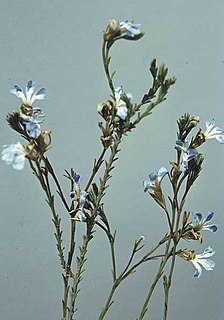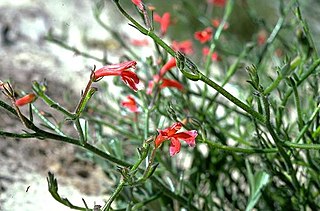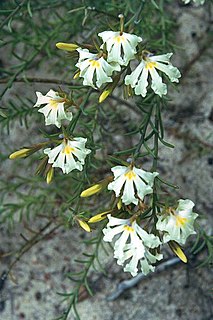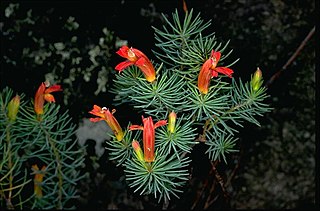
Lechenaultia is a genus of flowering plants in the family Goodeniaceae, the species native to Australia with one species also occurring in New Guinea. Plants in the genus Lechenaultia are glabrous shrubs or herbs with needle-shaped leaves, more or less sessile flowers with five sepals and five blue, white, or yellow and red petals in two unequal lobes, the fruit an elongated capsule.

Lechenaultia biloba, commonly known as blue leschenaultia, is a species of flowering plant in the family Goodeniaceae and is endemic to the south-west of Western Australia. It is a glabrous herb or subshrub with spreading branches, almost no leaves, and yellow, tube-shaped flowers.

Lechenaultia linarioides, commonly named yellow leschenaultia, is a species of flowering plant in the family Goodeniaceae and is endemic to near-coastal areas in the west of Western Australia. It is a sprawling subshrub with many tangled branches, narrow, crowded, rather fleshy leaves, and yellow and deep pink to purplish red flowers.

Lechenaultia macrantha, commonly known as wreath leschenaultia, is a species of flowering plant in the family Goodeniaceae and is endemic to inland areas of south-western Western Australia. It is a low-lying, wreath-like herb or subshrub with narrow, rather fleshy leaves, and yellow petals with deep pink or red wings.

Lechenaultia formosa, commonly known as red leschenaultia, is a species of flowering plant in the family Goodeniaceae and is endemic to the south-west of Western Australia. It is a prostrate or erect shrub or subshrub with crowded, narrow, fleshy leaves and scarlet or orange-red to pale orange flowers.

Lechenaultia acutiloba, commonly known as wingless leschenaultia, is a species of flowering plant in the family Goodeniaceae and is endemic to the south-west of Western Australia. It is a dome-shaped shrub with crowded, linear leaves and many tube-shaped, pale greenish-yellow flowers with blue tips.
Lechenaultia chlorantha, commonly known as Kalbarri leschenaultia, is a species of flowering plant in the family Goodeniaceae and is endemic to a restricted area near Kalbarri in Western Australia. It is a subshrub or shrub with many branches, crowded, narrow, fleshy leaves and pale bluish-green, tube-shaped flowers.

Lechenaultia floribunda, commonly known as free-flowering leschenaultia, is a species of flowering plant in the family Goodeniaceae and is endemic to the south-west of Western Australia. It is an openly-branched shrub or subshrub with crowded, narrow, fleshy leaves and compact groups of pale blue to pale mauve or creamy white flowers.
Lechenaultia galactites, commonly known as white leschenaultia, is a species of flowering plant in the family Goodeniaceae and is endemic to the south-west of Western Australia. It is an erect, robust subshrub or shrub with crowded, narrowly oblong to egg-shaped leaves, and white to pale blue flowers.

Lechenaultia heteromera, commonly known as claw leschenaultia, is a species of flowering plant in the family Goodeniaceae and is endemic to the south-west of Western Australia. It is a subshrub with a few wand-like branches, fleshy leaves, and white and pale blue flowers.

Lechenaultia hirsuta, commonly known as hairy leschenaultia, is a species of flowering plant in the family Goodeniaceae and is endemic to the west of Western Australia. It is a straggling, low-lying shrub with few branches, fleshy leaves, and scarlet flowers.
Lechenaultia juncea, commonly known as reed-like leschenaultia, is a species of flowering plant in the family Goodeniaceae and is endemic to the south-west of Western Australia. It is an erect, perennial herb or shrub with crowded, fleshy leaves, and pale blue flowers.

Lechenaultia longiloba, commonly named Irwin leschenaultia, is a species of flowering plant in the family Goodeniaceae and is endemic to the south-west of Western Australia. It is a straggling, low-lying herb or subshrub with narrow, rather fleshy leaves, and pale yellow or green petals with deep pink or red wings.
Lechenaultia lutescens is a species of flowering plant in the family Goodeniaceae and is endemic to inland central Australia. It is a wand-shaped, ascending herb or subshrub with rigid, narrow leaves, and orange-yellow to pale yellow or creamy-white flowers.
Lechenaultia papillata is a species of flowering plant in the family Goodeniaceae and is endemic to inland areas of south-western Western Australia. It is a diffuse, ascending shrub or subshrub with papillate, crowded, slightly fleshy leaves, and pale blue flowers.

Lechenaultia pulvinaris, commonly known as cushion leschenaultia, is a species of flowering plant in the family Goodeniaceae and is endemic to inland areas of south-western Western Australia. It is a low-lying, hemispherical shrub with narrow, rigid, crowded, hairy leaves, and pale blue or purple flowers.

Lechenaultia stenosepala, commonly known as narrow-sepaled leschenaultia,is a species of flowering plant in the family Goodeniaceae and is endemic to the south-west of Western Australia. It is an open, more or less erect perennial herb or shrub with crowded, narrow leaves, and blue to pale blue or creamy-white flowers.
Lechenaultia striata is a species of flowering plant in the family Goodeniaceae and is endemic to arid inland areas of Australia. It is an ascending herb or subshrub with only a few wand-like branches, crowded, narrow fleshy leaves and pale blue to pale yellow or creamy-white flowers.
Lechenaultia subcymosa, commonly known as wide-branching leschenaultia, is a species of flowering plant in the family Goodeniaceae and is endemic to the far west of south-western Western Australia. It is an ascending herb or subshrub with only a few widely spreading branches, narrow, rigid leaves crowded on short, leafy stems, and creamy-white to pale mauve flowers.

Lechenaultia superba, commonly known as Barrens leschenaultia, is a species of flowering plant in the family Goodeniaceae and is endemic to near-coastal areas of southern Western Australia. It is an erect, spreading shrub with crowded, narrow, fleshy leaves and yellow, red, or yellow and orange flowers.















